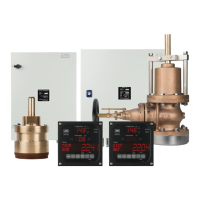3-3
1 General
The technical specification in this section deals with the JLN-900 system, including the
Transducer, Electronics unit, Log Processing Unit LPU2 and connected Display units.
Operating performance limits like inaccuracies or certain measurement criteria are set by the
speed sensors, i.e. the combination Transducer/Electronics unit.
2 Performance
The performance limits defined here are met when the log system is operating within the
environmental conditions described in this section and if calibration is correctly done.
2.1 Principle of operation
Log measures acoustic correlation using vertical beams. The log system uses two different
sensors, measuring Speed Through the Water (STW) and Speed Over the Ground (SOG)
simultaneously and independently.
2.1.1 STW (Speed Through the Water = relative speed)
Frequencies: In the range 3.8 – 4.2 MHz
Speed is measured in a water volume 120–140 mm from the surface of the transducer.
Depth requirement: greater or equal to 3 m beneath the transducer.
Speed range: +/-50 knots sensed Speed Through the Water.
2.1.2 SOG (Speed Over the Ground = true speed)
Frequency: 150 kHz
Depth requirement: greater or equal to 2 m beneath the transducer.
Depth range: nominally 2 - 250 m below transducer.
Speed range: 40 knots in any direction.
2.2 Accuracy of measurement
2.2.1 STW
Speed error relative to sensed water speed: 0.1 knot or 1 %, whichever is greater.
Distance error relative to travelled distance (through the water): 1 %.
2.2.2 SOG
The SOG measurement system operates in different modes resulting in different accuracy of
the measurement. The "Normal mode" provides better accuracy and is active when the speed
and depth product (metres * knots) is above 67. The "Interpolation mode" is active when this
condition is not met resulting in a lower accuracy.
Normal mode: 0.1 knot or 1 %, whichever is greater.
Interpolation mode: 0.2 knots or 2 %, whichever is greater.
Distance error will improve with distance due to averaging positive and negative
instantaneous errors. Therefore, the error limit, expressed as a percentage of the travelled
distance, will decrease with increased accumulated distance.

